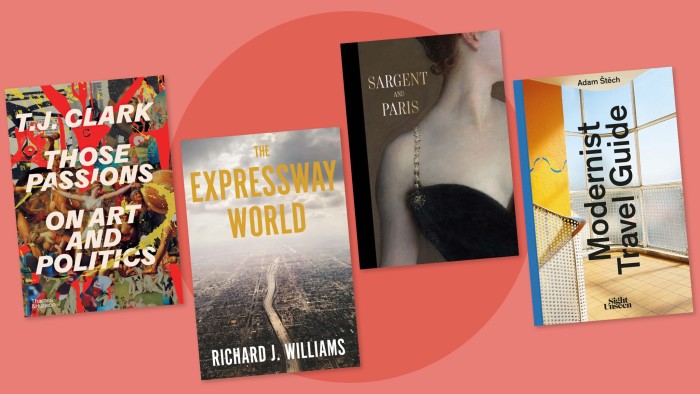Unlock the Editor’s Digest for free
Roula Khalaf, Editor of the FT, selects her favourite stories in this weekly newsletter.
Visual Arts
by Jackie Wullschläger
Famm: Female Artists of the Mougins Museum, France by Samantha Baskind, Jennifer R Cohen and others (Merrell)
A rare pleasure: a book entering the minefield of art and gender politics with sense, sensitivity, style and surprises. A record of collector Christian Levett’s FAMM museum, opened last year, it offers an alternative modern art history, from undisputed greats — Berthe Morisot, Joan Mitchell, Louise Bourgeois — to many intriguing lesser-known names.
American Photography edited by Mattie Boom and Hans Rooseboom (Netherlands Architecture Institute)
Photography entered everyday life, created American identity and shaped the American dream from the mid-19th century until now. Spanning documentary images, family snapshots, advertisements, protest posters, this rich account expands on the Rijksmuseum’s recent exhibition, unfolding both American history and the evolution of photography: democratic, accessible, innovative, and eventually ubiquitous.
Those Passions: On Art and Politics by TJ Clark (Thames & Hudson)
A lifetime’s thinking about painting’s relationship with politics and how “modern art has responded to the danger of modern life” is condensed in Clark’s exhilarating, original and urgent volume of essays. He is revelatory on Velázquez, Delacroix, Picasso, French impressionism, Russian formalism and much more, in prose soaring on the conviction that art matters and reflects social and emotional experience.
Sargent and Paris edited by Stephanie L Herdrich (Metropolitan Museum of Art)
Marking the centenary of Sargent’s death, the exquisitely produced, gold-embossed catalogue of the Metropolitan Museum and Musée d’Orsay’s major exhibition about his formation in the French capital is significant in its own right, biographically and artistically illuminating, and a sparkling compensation for those who can’t get to the show.
The National Gallery: Paintings, People, Portraits edited by Anh Nguyen and Rebecca Marks (Taschen)
Rehung, refurbished, boasting stellar exhibitions and new acquisitions, the National Gallery in its bicentennial year triumphed on all fronts. This lavish outsize volume is an extravagant and delectable monument to its history, valuable especially for the quality and quantity of reproduced paintings, but also for wise commentaries, notably from living artists.
Summer Books 2025

All this week, FT writers and critics share their favourites. Some highlights are:
Monday: Business by Andrew Hill
Tuesday: Environment by Pilita Clark
Wednesday: Economics by Martin Wolf
Thursday: Fiction by Maria Crawford
Friday: Politics by Gideon Rachman
Saturday: Critics’ picks

Architecture and Design
by Edwin Heathcote
Dirty Old River by Tom Emerson (Park Books)
Named after an essay about a walk along the river Thames, this collection of essays and articles by Emerson, co-founder of 6a Architects, is a rare piece of readable and engaging writing from a practising architect. He is concerned not so much with theory as with how things are made and why, and with the connections between them. From essays on Frank Gehry’s early houses to Álvaro Siza’s window details and the writings of Georges Perec, it covers a lot of ground with a refreshing lightness of touch.
The New Design Museum: Co-Creating the Present, Prototyping the Future by Beatrice Leanza (Park Books)
The contemporary museum of design can be stuck between the world of art and of things but Leanza makes a case for it as a public forum. She uses interviews with museum directors and curators to outline the potential of the museum and of design as a fast-changing field of transformative ideas. There is plenty of curator-speak but do power through that for some genuinely radical ideas.
Ukrainian Modernism by Dmytro Soloviov (Fuel)
It is a painful time to write about Ukrainian architecture when so much of it is being destroyed. Yet this elegiac book becomes even more essential as a record of an astonishingly varied, Soviet-era architecture spanning everything from housing to public projects. Here it is clear that much socialist building was a striking blend of art, sculpture and architecture. There is a good introduction by Owen Hatherley, and part of the proceeds go to the Red Cross appeal for Ukraine.

Modernist Travel Guide by Adam Štěch (Sight Unseen)
Czech photographer and writer Štěch has one of the best Instagram feeds in architecture, recording lesser-known, often eccentric, always remarkable surviving modernist interiors and buildings around central Europe and the wider world. This pocket travel guide is packed with wonderful gems, a rare translation of good social media into publishing.
The Expressway World by Richard J Williams (Polity)
With its Ballardian title, this book concentrates on one of the most contested legacies of modernism: the urban expressway, cutting through cities, splitting neighbourhoods, polluting with noise and particulates and killing both social and financial value. Williams looks at how we got here and what might be done. There is plenty of optimism here, with the various ways in which neglected real estate around freeways can be repurposed, and how it might actually present an opportunity.
Tell us what you think
Will you be taking any of these books on your summer holiday this year? Which ones? And what titles have we missed? Let us know in the comments below
Join our online book group on Facebook at FT Books Café

Leave a Reply